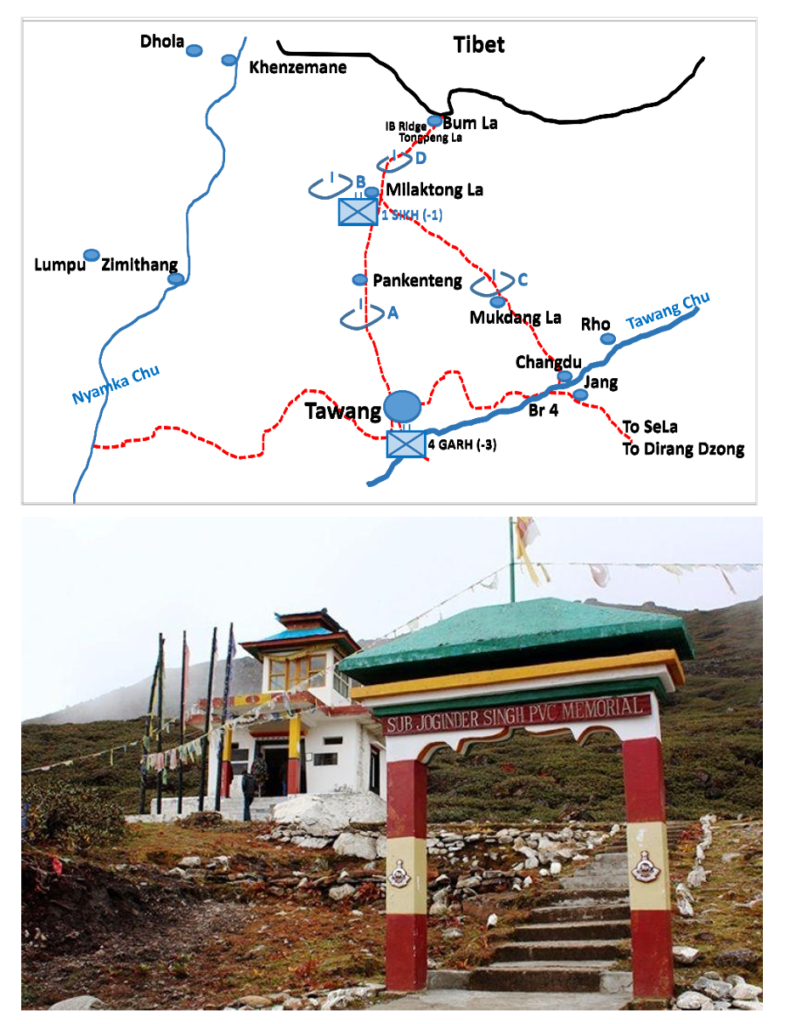


Tawang – elevation 3,048 metres (10,000 ft) in the northwestern part of Arunachal Pradesh then NEFA. Bum La Pass (15, 200 Ft) located 37 km away from Tawang by road. A 26-km Bum La Tawang foot-track was the shortest approach to Tawang. 3 km southwest of Bum La, west of the foot-track stood the feature called ‘Twin Peaks’. 1st Battalion, the SIKH Regiment was responsible to deny this approach to the Chinese. Delta Company was deployed at Tongpeng La, a pass situated a km southwest of the ‘Twin Peaks’. Between the ‘Twin Peaks’ and Bum La, existed an Inspection Bungalow (IB). 11th Platoon of Delta Company, under Subedar Joginder Singh, deployed at the nearby IB ridge and set up defences to halt the Chinese advance in their tracks. 7 (Bengal) Mountain Battery provided artillery cover with the artillery observation post officer located at Tongpeng La. At dawn on 20 Oct, a JCO of the Assam Rifles outpost at Bum La noticed hundreds of Chinese soldiers preparing for an attack. He alerted the 11th platoon (23 troops). Joginder promptly despatched a section of about 10 men under Havildar Sucha Singh to reinforce the Bum La-post.

The attack came at 4.30 AM on 23 Oct with volleys of mortar and anti-tank guns followed by an assault on the Assam Rifles post at 6 AM. Sucha Singh’s Section killed several Chinese before withdrawing to the IB ridge. Having overrun the Assam Rifles outpost, with the objective of capturing ‘Twin Peaks’, the enemy launched an assault on IB ridge. Subedar Joginder Singh had prepared his defences well. Other than this the troops were ill-prepared – logistically they had: a stock of four days’ rations, no snow boots, only canvas made jungle shoes, no winter clothing and limited ammunition. The gunfight began soon; mortars and artillery guns engaged the enemy with effect and mounting casualties compelled the Chinese to retreat. Even the SIKHs suffered and only 17, half the platoon, survived the Chinese offensive. Having repulsed the first wave, Joginder sent three men to the company HQs to fetch ammunition. The Chinese attacked again in greater strength, an echelon climbed unobserved from the right flank. The assault was far more ferocious. Joginder took a machinegun burst on his thigh. Dripping blood, he tied a field dressing on his wound. Joginder refused to be evacuated and continued screaming instructions. He manned a machine gun and inspired his men to hold ground.

They forgot their fear and stood fast with their leader. When the 2-inch mortar exhausted its bombs, Lance Naik Santokh Singh manning the mortar leapt up and killed two Chinese with the barrel before he was shot dead. However, the platoon suffered serious losses and soon the Chinese were swarming all over the IB Ridge. The Company Commander sensing a loss of the position, as a final resort, radioed Joginder if he could direct SOS fire on himself. (This meant calling Artillery Fire onto own position – causing serious casualties to own as well as the enemy troops who were now swarming the defensive position) …… Subedar Joginder Singh’s answer was ‘Yes’. The enemy was shocked. Joginder had readied the remaining platoon for a head-on, final attack. Shouting ‘Bole So Nihal Sat Sri Akal’, the SIKHs killed a score of Chinese soldiers in the bayonet charge …. The Chinese never expected the SIKHs would leave their trenches and charge with such intensity.
The Chinese troops however came in waves and continued to clamber up overpowering Joginder in close quarter combat. All but four soldiers from the platoon perished. Badly wounded Subedar Joginder Singh was taken prisoner, the other three gave the slip, trekked to the main defences at Se La, and narrated the ringside account of the battle that raged for four hours. No one had expected the locality to hang on for so long and so resolutely against 100s of Chinese. A Chinese surgeon informed Subedar Joginder Singh that his leg had to be amputated. He refused because he was due for promotion as a Subedar Major. He thought that if amputated, he would lose his due promotion. The valiant Subedar unfortunately, passed away due to gangrene soon after.
The Indian Government awarded Sub Joginder Singh the Param Vir Chakra for his leadership and gallantry. Out of the 23 men only three men survived, the rest died fighting at IB Ridge. Indeed, a ‘Battle of the Last Man to the Last Round’. On learning that Joginder was awarded the Param Vir Chakra, Chinese army, in a mark of respect, repatriated his ashes with full military honours – No tribute can be greater. A memorial has been constructed at Bumla to honour the brave soldier. This memorial is like a temple visited by all before being deployed in the region. The ‘spirit’ of Subedar Joginder Singh continues to guard the icy slopes of the treacherous Tawang region.
